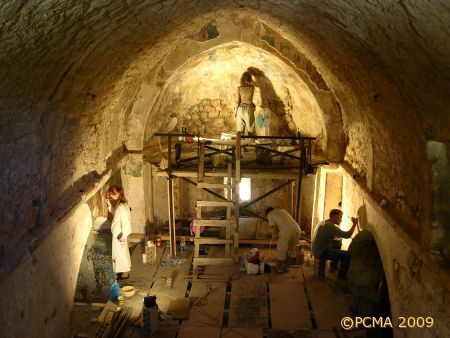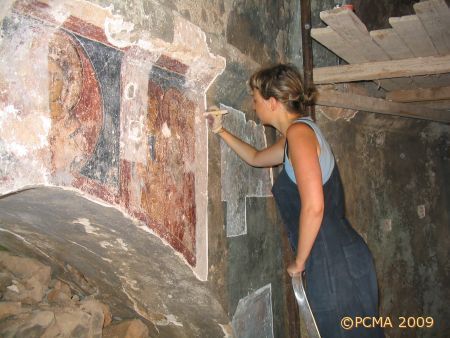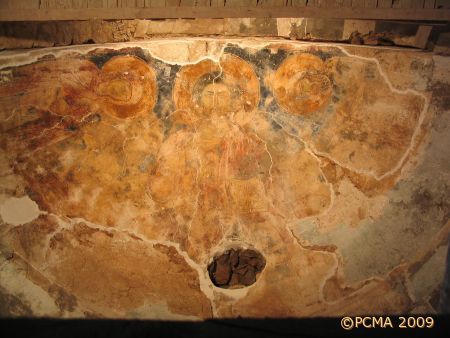Restoration of Wall Paintings in a Church in Kaftun (Lebanon)
Dates: 17 June–28 July 2007
Team:
Dr. Krzysztof Chmielewski – director and chief restorer (Department of Art Conservation and Restoration, Academy of Fine Arts in Warsaw)
Dr. Tomasz Waliszewski – co-director (Institute of Archaeology, University of Warsaw)
Maciej Baran – restorer (Department of Art Conservation and Restoration, Academy of Fine Arts in Warsaw)
Jolanta Gorniak – architect (Warsaw University of Technology)
Karol Juchniewicz – archaeologist (Institute of Archaeology, University of Warsaw)
Students from the Department of Art Conservation and Restoration of the Academy of Fine Arts in Warsaw:
Krzysztof Janowicz, Adam Maciejewski, Jan Morzycki-Markowski, Katarzyna Onisk, Natalia Sikorska, Anna
Tomkowska, Radosław Tusznio
Unable to take up regular excavation work due to the volatile political situation in the Middle East this year, the PCMA team intensified its conservation and restoration effort at Kaftun. Six weeks of work resulted in new material redefining current knowledge and pointing to new avenues in future research on Lebanon‘s past.
It was a busy June and July for the twelve restorers, archaeologists and students from the Academy of Fine Arts in Warsaw and the PCMA. The team spent the time meticulously cleaning murals which had been discovered during two earlier campaigns in the medieval church of the Saints Sergius and Bacchus belonging to an Orthodox monastery in Kaftun, south of Tripoli in northern Lebanon. Iconographical analysis of the wall decoration has placed it with considerable likelihood in the last quarter of the 13th or the beginning of the 14th century.

The murals need to be cleaned of the later plaster coats which had concealed them for centuries and from the dirt and soot that had obscured them in the first place. The restoration and preservation effort is aimed at creating a proper church interior for renewed sacral function, showcasing the medieval masterpieces without endangering them in any way. Once restored, paintings were transferred back to their original position inside the church. Documentalists concentrated on recording in detail the Greek, Syriac and Arabic inscriptions found on the murals.

Further studies of the church architecture yielded evidence of at least six building phases. The church, which appears to have been rebuilt several times since its erection, is clearly older than the paintings; it may have been founded even before the 13th century.
Documentation of remnants of medieval structures in the immediate surroundings of the church, probably belonging to the monastery, identified two cisterns and a wine press hewn in bedrock under the present-day monastic buildings.
The discovery of the Kaftun paintings spurs interest in two areas of research which have up till now been neglected in Lebanon studies: the art of the medieval Christian East and church architecture of this period.

The form and workmanship of the paintings from Kaftun put them among the most exquisite of their kind ever found in Lebanon. But they are also remarkable for their style. They seem to be the product of a local school, the creations of which – such as icons – have been identified for example in the collections of St. Catherine’s Monastery in the Sinai.
Further research in these fields may follow soon, assuming the mission carried out its plans for archaeological and restoration work in two other Lebanese churches of this period.
A comprehensive report on the work in Kaftun has been published in the Bulletin d’Archéologie et d’Architecture Libanaises 10 (2006).
(Text: K. Chmielewski, T. Waliszewski)
